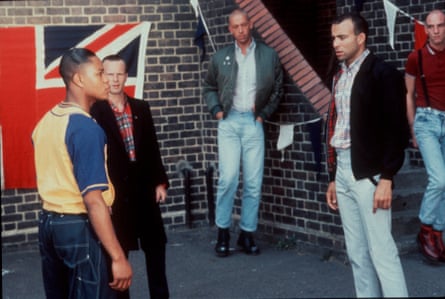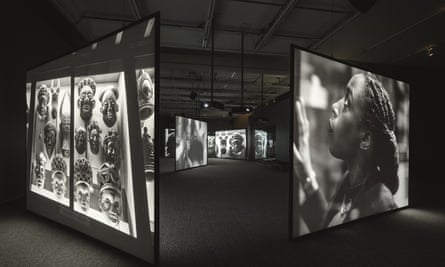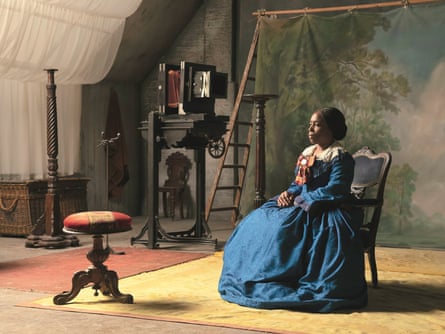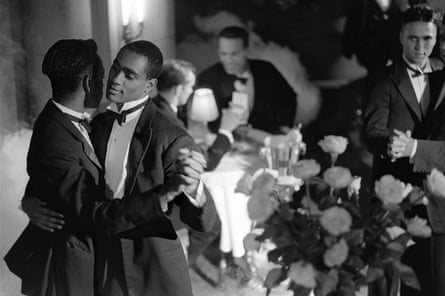Artist Isaac Julien: ‘I didn’t know if I’d live on until the 90s. A lot of my friends didn’t’ | Art
Isaac Julien’s canalside London studio was designed by David Adjaye at the same time the architect was working on his National Museum of African American History and Culture in Washington DC; its library space, where we talk, is warm, luxurious and boat-like. Adjaye’s team has also designed Julien’s imminent career retrospective at Tate Britain, which will display the artist and film-maker’s exploration of migration, history, sexuality and culture through composite multiscreen installations that can make you feel as if you’re actually inside the work.
“We’ve made a radical intervention into the museum,” Julien promises, and I understand immediately what he means. His most famous works, the 1989 short film Looking for Langston and the 1991 feature Young Soul Rebels, are both landmarks of the Black queer experience and youth culture. Looking for Langston was shown at the Barbican in 2020, and it was startling when Todd Terry’s 1988 acid house classic Can You Party? thumped into the space at full volume – a spontaneous queer rave in response to a police raid. Wherever you were in the gallery, you would turn to see where the music was coming from; it was a provocative intervention in the summer of Black Lives Matter.
When I mention it, Julien recalls the 2001 Turner prize private view, where an attender told him, “Your work’s quite loud. Do you think you could turn it down?” “I wanted to invade the museum,” he says. “That’s the whole reason I’m making my work. There will be a cacophony of sound. I’m interested in turning habits of how we want to meditate on art inside out.”
Before he arrives, dressed glamorously in black Issey Miyake pleats, his assistants show me his latest film, the relatively quiet Once Again … (Statues Never Die), an immersive five-screen installation. Sheltered from a deadening snowfall, Alain Locke, a central figure of the Harlem Renaissance (played by Moonlight’s André Holland), strolls through the halls of a museum to the mournful soprano tones of jazz singer Alice Smith, and gazes up at statues of Aristotle, Hippocrates, Joseph Priestley and Roger Bacon to a lyrical narration in Creole, “a language not meant to be understood by the white master, a language of resistance,” Julien explains. Locke then encounters Albert C Barnes, an early 20th-century collector of African art, and they debate its place – stolen, often violently, from its custodians – in the modern museum.
Once Again … interpolates several scenes from Looking for Langston, in which Locke is also depicted; a full-circle moment. “I’ve been looking at conversations connected to modernisms in the early 20th century that have come back to haunt the early part of the 21st century, the role of African art in a museum collection and who has the power to interpret it,” Julien says. “We went back to the out-takes and found elements that we could suture back together, bringing the Alain Locke character back to life in a different kind of way.”
It also includes shots from a 1970 short by Ghanaian film-maker Nii Kwate Owoo called You Hide Me, in which an African student uncovers a hoard of African artefacts held in the British Museum archive. Julien lived next door to the British Museum for several years, “wondering how it could call itself the British Museum when it’s more of a colonial project. You had film-makers like Kwate who were calling this into question half a century ago.”

Julien was born in London in 1960 to parents who had migrated from St Lucia. In 1979, he made a student film focusing on how gay men are stereotyped in the media. His tutor encouraged him to think about how Black gay men are stereotyped, and this question indirectly led to Looking for Langston. By then, he had graduated from Central Saint Martins and co-formed Sankofa Film and Video Collective, whose best known work, The Passion of Remembrance, Julien co-directed with Maureen Blackwood. Restored by Julien and set for release this month by the BFI, it depicts the diversity of the Black British experience through one family.
In the mid-1980s, Julien was mentored by the “very generous” Derek Jarman, whose films, such as Edward II and Caravaggio, inspired the visual language Julien would develop in Looking for Langston. “I was part of a movement where younger queer film-makers could intervene through facilitators like Channel 4 and as part of a general fightback within gay subcultures against such oppressions as section 28 and Thatcherism.”
The 80s were a rich decade for Black British cultural alliances, with the emergence of, among others, the Theatre of Black Women, the Black Audio Film Collective and the Blk Art Group. Like most of the artists connected to these groups, Julien was involved in community activism. This year marks the 40th anniversary of his debut film Who Killed Colin Roach?, which documented the protests that followed Roach’s death by gunshot wound at the entrance of a police station, which the police claimed was a suicide (a claim that was later upheld by an inquest). Rediscovered prints Julien took on the day of the protest form a collage along a wall of the studio.

Julien was also a member of the Gay Black Group before the Aids crisis began to wreak disproportionate havoc among Black gay men. “You’re dealing with your friends dying and that whole question of mortality becomes very close to how you live,” he says. “Your sensitivity is heightened. I didn’t know if I’d live on until the 90s. A lot of my friends didn’t, so why would I?”
Like much of his work, Young Soul Rebels – set in 1977, and so pre-Aids – and Looking for Langston refocus the gaze away from that of the dominant media and into the custody of those at its subjective centre. In Looking for Langston, the queer African American poet Essex Hemphill narrates his poem If His Name Were Mandingo to shots of Robert Mapplethorpe’s portraits of Black men, as a means of critiquing the fetishistic gaze Mapplethorpe had enabled.
after newsletter promotion
Julien’s films poeticise Black acts of resistance around issues of sexuality, migration and modern slavery. His 2007 work Western Union: Small Boats meditates on the wave of migration from northern Africa to southern Europe, while referencing Luchino Visconti’s 1963 film The Leopard. Julien decided to make the five-screen installation after holidaying in Italy regularly with his mother, and gradually feeling less welcomed by the locals. “People’s looks started to change slightly when African populations began to grow within these vicinities,” he notes.
When Julien first started researching Western Union: Small Boats, his initial idea was to juxtapose the movement of people from Africa to Europe with the Chinese cockle pickers who tragically drowned at Morecambe Bay in 2004. “I wanted to allegorise these movements and to that end we looked at different mythologies.”

He became acquainted with the fables of Mazu, a 15th-century deity from the Fujian province, from where the cockle pickers had also travelled. He and his researchers were able to find prints – “in the British Museum’s colonial archive, of all places” – of The Tale of Meizhou Island, a fable in which Mazu loses her power and is no longer able to save sailors from danger at sea, but brings them to Meizhou, the island of safety.
“I wanted to translate that myth to the present day and to look at Mazu as someone whose powers are waning; she wasn’t able to save the cockle pickers,” he explains. “People from that province had been migrating for thousands of years. Through Mazu’s gaze, I could look to Chinese culture as a way of saying that the question around migration is a provincial, European conversation or problem.”
Ten Thousand Waves, featuring Maggie Cheung as Mazu, is a collaboration with the Chinese poet Wang Ping, whom Julien met in 2006 and brought to Morecambe Bay; she produced a poem that “became instructional of the work”. Julien worked with a team of more than 100 Chinese cast and crew. This Black-Asian collaboration appears particularly topical, given, he says, “the Black-Asian collaboration we have in current government who are repudiating people of Black and Asian backgrounds in this debate” – for instance the successive home secretaries Priti Patel and Suella Braverman, who have targeted migrants of colour in their anti-immigration policies; or Kemi Badenoch, who as education secretary said that schools “should not openly support the anti-capitalist Black Lives Matter group”, a movement Kwasi Kwarteng, Britain’s first Black chancellor, accused of a “cartoon-like view of the past”.“Whether it’s about technological development, or where a capital is located, bodies tend to follow,” Julien says, reminding me of Ian Sanjay Patel’s We’re Here Because You Were There, a study of how the legacies of empire continue to affect migration. “I don’t know how successful this current government will be in stopping those global movements taking place, because they’ll happen whether we like it or not.” Through a holistic exploration of place, memory, migration and identity within a decolonial museum project, Julien’s oeuvre is a compelling, sensual, critically sound riposte to such divisive views.
Isaac Julien’s canalside London studio was designed by David Adjaye at the same time the architect was working on his National Museum of African American History and Culture in Washington DC; its library space, where we talk, is warm, luxurious and boat-like. Adjaye’s team has also designed Julien’s imminent career retrospective at Tate Britain, which will display the artist and film-maker’s exploration of migration, history, sexuality and culture through composite multiscreen installations that can make you feel as if you’re actually inside the work.
“We’ve made a radical intervention into the museum,” Julien promises, and I understand immediately what he means. His most famous works, the 1989 short film Looking for Langston and the 1991 feature Young Soul Rebels, are both landmarks of the Black queer experience and youth culture. Looking for Langston was shown at the Barbican in 2020, and it was startling when Todd Terry’s 1988 acid house classic Can You Party? thumped into the space at full volume – a spontaneous queer rave in response to a police raid. Wherever you were in the gallery, you would turn to see where the music was coming from; it was a provocative intervention in the summer of Black Lives Matter.
When I mention it, Julien recalls the 2001 Turner prize private view, where an attender told him, “Your work’s quite loud. Do you think you could turn it down?” “I wanted to invade the museum,” he says. “That’s the whole reason I’m making my work. There will be a cacophony of sound. I’m interested in turning habits of how we want to meditate on art inside out.”

Before he arrives, dressed glamorously in black Issey Miyake pleats, his assistants show me his latest film, the relatively quiet Once Again … (Statues Never Die), an immersive five-screen installation. Sheltered from a deadening snowfall, Alain Locke, a central figure of the Harlem Renaissance (played by Moonlight’s André Holland), strolls through the halls of a museum to the mournful soprano tones of jazz singer Alice Smith, and gazes up at statues of Aristotle, Hippocrates, Joseph Priestley and Roger Bacon to a lyrical narration in Creole, “a language not meant to be understood by the white master, a language of resistance,” Julien explains. Locke then encounters Albert C Barnes, an early 20th-century collector of African art, and they debate its place – stolen, often violently, from its custodians – in the modern museum.
Once Again … interpolates several scenes from Looking for Langston, in which Locke is also depicted; a full-circle moment. “I’ve been looking at conversations connected to modernisms in the early 20th century that have come back to haunt the early part of the 21st century, the role of African art in a museum collection and who has the power to interpret it,” Julien says. “We went back to the out-takes and found elements that we could suture back together, bringing the Alain Locke character back to life in a different kind of way.”
It also includes shots from a 1970 short by Ghanaian film-maker Nii Kwate Owoo called You Hide Me, in which an African student uncovers a hoard of African artefacts held in the British Museum archive. Julien lived next door to the British Museum for several years, “wondering how it could call itself the British Museum when it’s more of a colonial project. You had film-makers like Kwate who were calling this into question half a century ago.”

Julien was born in London in 1960 to parents who had migrated from St Lucia. In 1979, he made a student film focusing on how gay men are stereotyped in the media. His tutor encouraged him to think about how Black gay men are stereotyped, and this question indirectly led to Looking for Langston. By then, he had graduated from Central Saint Martins and co-formed Sankofa Film and Video Collective, whose best known work, The Passion of Remembrance, Julien co-directed with Maureen Blackwood. Restored by Julien and set for release this month by the BFI, it depicts the diversity of the Black British experience through one family.
In the mid-1980s, Julien was mentored by the “very generous” Derek Jarman, whose films, such as Edward II and Caravaggio, inspired the visual language Julien would develop in Looking for Langston. “I was part of a movement where younger queer film-makers could intervene through facilitators like Channel 4 and as part of a general fightback within gay subcultures against such oppressions as section 28 and Thatcherism.”
The 80s were a rich decade for Black British cultural alliances, with the emergence of, among others, the Theatre of Black Women, the Black Audio Film Collective and the Blk Art Group. Like most of the artists connected to these groups, Julien was involved in community activism. This year marks the 40th anniversary of his debut film Who Killed Colin Roach?, which documented the protests that followed Roach’s death by gunshot wound at the entrance of a police station, which the police claimed was a suicide (a claim that was later upheld by an inquest). Rediscovered prints Julien took on the day of the protest form a collage along a wall of the studio.

Julien was also a member of the Gay Black Group before the Aids crisis began to wreak disproportionate havoc among Black gay men. “You’re dealing with your friends dying and that whole question of mortality becomes very close to how you live,” he says. “Your sensitivity is heightened. I didn’t know if I’d live on until the 90s. A lot of my friends didn’t, so why would I?”
Like much of his work, Young Soul Rebels – set in 1977, and so pre-Aids – and Looking for Langston refocus the gaze away from that of the dominant media and into the custody of those at its subjective centre. In Looking for Langston, the queer African American poet Essex Hemphill narrates his poem If His Name Were Mandingo to shots of Robert Mapplethorpe’s portraits of Black men, as a means of critiquing the fetishistic gaze Mapplethorpe had enabled.
after newsletter promotion
Julien’s films poeticise Black acts of resistance around issues of sexuality, migration and modern slavery. His 2007 work Western Union: Small Boats meditates on the wave of migration from northern Africa to southern Europe, while referencing Luchino Visconti’s 1963 film The Leopard. Julien decided to make the five-screen installation after holidaying in Italy regularly with his mother, and gradually feeling less welcomed by the locals. “People’s looks started to change slightly when African populations began to grow within these vicinities,” he notes.
When Julien first started researching Western Union: Small Boats, his initial idea was to juxtapose the movement of people from Africa to Europe with the Chinese cockle pickers who tragically drowned at Morecambe Bay in 2004. “I wanted to allegorise these movements and to that end we looked at different mythologies.”

He became acquainted with the fables of Mazu, a 15th-century deity from the Fujian province, from where the cockle pickers had also travelled. He and his researchers were able to find prints – “in the British Museum’s colonial archive, of all places” – of The Tale of Meizhou Island, a fable in which Mazu loses her power and is no longer able to save sailors from danger at sea, but brings them to Meizhou, the island of safety.
“I wanted to translate that myth to the present day and to look at Mazu as someone whose powers are waning; she wasn’t able to save the cockle pickers,” he explains. “People from that province had been migrating for thousands of years. Through Mazu’s gaze, I could look to Chinese culture as a way of saying that the question around migration is a provincial, European conversation or problem.”
Ten Thousand Waves, featuring Maggie Cheung as Mazu, is a collaboration with the Chinese poet Wang Ping, whom Julien met in 2006 and brought to Morecambe Bay; she produced a poem that “became instructional of the work”. Julien worked with a team of more than 100 Chinese cast and crew. This Black-Asian collaboration appears particularly topical, given, he says, “the Black-Asian collaboration we have in current government who are repudiating people of Black and Asian backgrounds in this debate” – for instance the successive home secretaries Priti Patel and Suella Braverman, who have targeted migrants of colour in their anti-immigration policies; or Kemi Badenoch, who as education secretary said that schools “should not openly support the anti-capitalist Black Lives Matter group”, a movement Kwasi Kwarteng, Britain’s first Black chancellor, accused of a “cartoon-like view of the past”.“Whether it’s about technological development, or where a capital is located, bodies tend to follow,” Julien says, reminding me of Ian Sanjay Patel’s We’re Here Because You Were There, a study of how the legacies of empire continue to affect migration. “I don’t know how successful this current government will be in stopping those global movements taking place, because they’ll happen whether we like it or not.” Through a holistic exploration of place, memory, migration and identity within a decolonial museum project, Julien’s oeuvre is a compelling, sensual, critically sound riposte to such divisive views.
